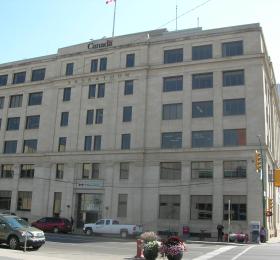Federal Building
- Regular
Description of the Historic Place
The Federal Building is a five-storey raised office building that was constructed in 1929. Located in downtown Saskatoon at 101 22nd Street East, the Federal Building features a ‘Scraped’ Beaux Arts style of architecture. This style is known for the balance and symmetry characteristic of the Beaux Arts style, but with a more subdued approach in terms of ornamentation.
Heritage Value
The Federal Building was designed by the Federal Department of Public Works under the supervision of Chief Architect T.W. Fuller. Its heritage value lies in its ‘Scraped’ Beaux Arts style of architecture, which was a response to the hard economic conditions that prevailed at the time of construction. Extensive and elaborate ornamentation represented significant costs which could not be justified during periods of economic hardship.
The Federal Building features three major bays on the front (22nd Street) facade with the centre bay projecting slightly. The east side wall is of buff brick, and the windows have flat voissours with limestone sills. The front façade of the Federal Building is Tyndall stone and at the centre is a parapet with a slightly-arched name panel and metal coping. The interior of the Federal Building was extensively renovated in 1961 under architect Frank P. Martin.
The building has housed many different government offices like Weights & Measures, the Department of Agriculture, Immigration Offices, and the Post Office. With its massive and simple style of architecture, the Federal Building continues to represent the finest in material finish and workmanship today.
Source: City of Saskatoon Built Heritage Database
Character Defining Elements
Key elements which contribute to the heritage value of this historic resource include:
- Its ‘Scraped’ Beaux Arts style of architecture, evident in: its brick and Tyndall stone facade; parapet; sign facia and framed pilasters on the main entry door; and its cornices and frieze; and
- Those features that relate to its historical context including its original exterior iron lights with frosted glass globes; and the "CANADA" and "SASKATOON" lettering.

